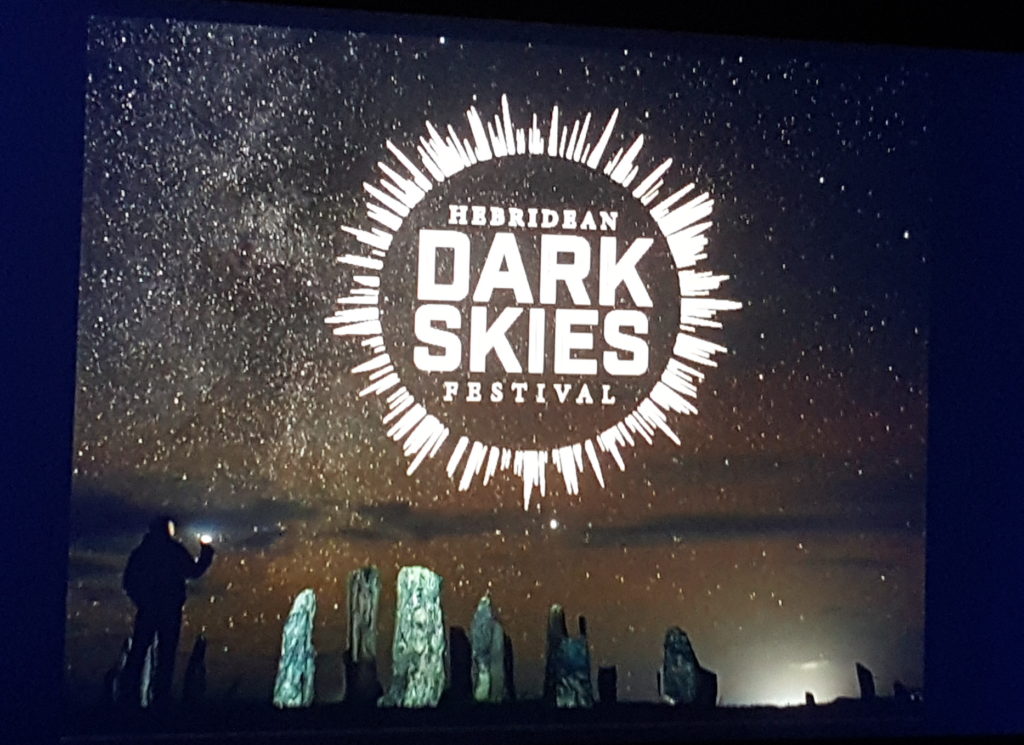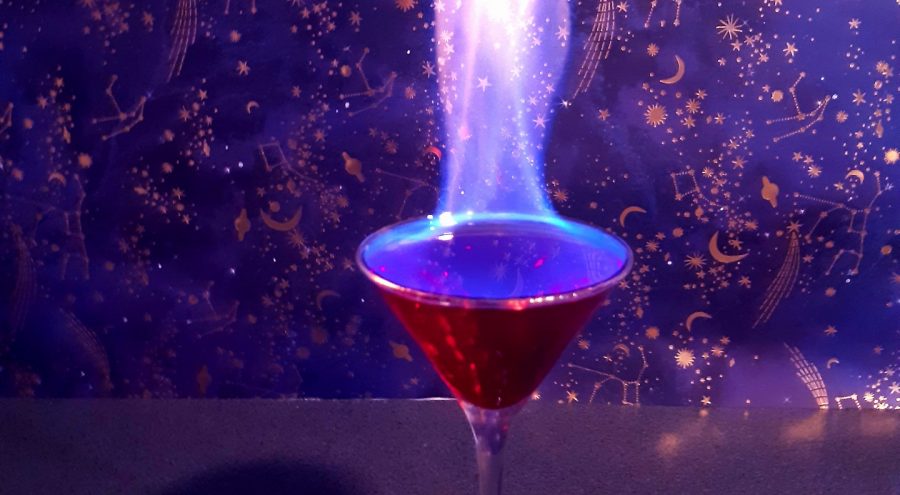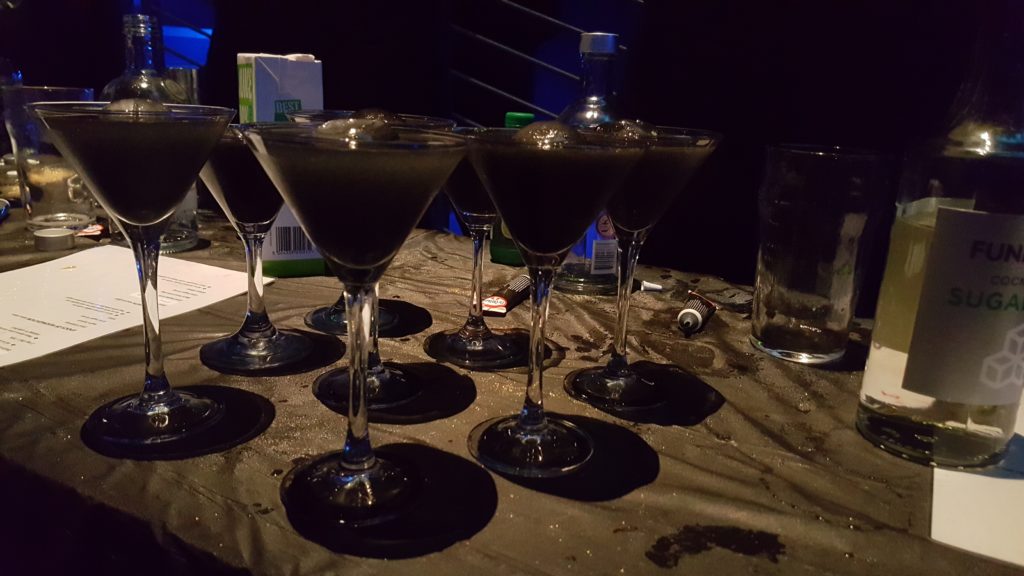Cosmic Cocktails: Explaining Cosmology with Drinks in the Outer Hebrides
I had the great pleasure of taking the g-Astronomy project to Scotland in February 2020, on the kind invitation of the Hebridean Dark Skies Festival. One of the events was held at the An Lanntair arts centre, where in collaboration with Kirsty MacKinnon Lease and her wonderful cafe bar team, we devised a series of three cocktails to talk about cosmology in a fun, engaging and hopefully entertaining way.
The public did seem to love it – and the cosmology explanations appeared to make more and more sense as the evening (and the alcohol level) progressed…

Primordial Fireball
Rum, raspberries, thyme and Big Bang blaze… the flaming start to your g-Astronomical journey through the cosmos

All of you will have a much closer connection with Nature and with the night sky than I, living as you do in a wonderful island and a wonderfully dark place. So you will already be finely attuned to the whole idea behind the g-Astronomy project: namely, to develop novel and entertaining ways of talking about what are usually perceived as far-away subjects, like the big bang, black holes and the night sky all around us. What we would like to achieve is to create a more visceral connection with these ideas – and what better way to do that than with some creative cocktails!
The first cocktail tonight is called Primordial Fireball, for obvious reasons I’m sure. Now that you have all been served, I encourage you to count from 1 to 380,000, please – the number of years from the Big Bang to the moment when the primordial fire goes off.
100,000 – 200,000 – 300,000 – 380,000 please blow your cocktail off!
As you enjoy this wonderful cocktail, here is some context for its creation.
When Einstein came up with General Relativity and tried to apply it to the universe as a whole in 1916, he believed the universe was static, ie., unchanging with time. So he fiddled with his equations to make sure he got what he wanted: a static universe that did not evolve. However, in 1929 Edwin Hubble discovered that the universe is expanding, so Einstein was forced to change his mind, calling the static universe idea (reportedly) his “greatest blunder”. Even so, the implication of a primordial atom (in the words of astronomer, mathematician and Belgian priest Georges Lemaitre) was not universally accepted. The great British astronomer Fred Hoyle derogatively called in the 1950s this idea “the Big Bang”, meaning to say that it was a preposterous notion.
However, in 1964 two radio engineers, Penzias and Wilson, discovered by mistake the left-over radiation from the Big Bang, thus providing incontrovertible proof that our universe did have a hot, dense, flaming beginning (just like your cocktail) 13.8 billion years ago.
In your cocktail, time flows from the bottom to the top: just like the universe, the martini glass in which it is served grows from the bottom to the top – the universe is expanding with time. What the glass does not show – can not show! – is the exponential size of the expansion in the first 10E-32 seconds: so quick that it blows up a patch of the universe the size of an atomic nucleus to 10 times the size of the visible universe today!
At the beginning of time, the universe is filled with energy (in the form of light), normal matter (mostly hydrogen, 75% of the total, the simplest of atoms – however, the energy is such that the electron around it is stripped away and so the hydrogen atom is made just of a single proton), dark matter and neutrinos.
Because electrons are free to roam, light rays get intercepted by the electrons and cannot travel in a straight line: the universe is opaque, like a bank of fog, or like your drink, whose colour represents the high-energy plasma that filled the universe in its primordial epoch.
As the universe expands, it cools down until eventually the temperature is low enough (3000 degrees!) for electrons to be captures by the hydrogen atoms (protons): the universe becomes at this point transparent to light, and light beams are released so they can travel all the way to us today, 13.8 billion years later.
By this point in time, I expect most of your glasses to have become transparent too, as the “plasma” they contained has dissolved… transferred into your bellies!
Epoch of Reionization
A golden star of Colonsay gin, lemon, mint
and elderflower tonic to light up your palate

This second cocktail takes us about 200 million years forward in time.
Not much has happened in the universe since the last event (namely, you drinking the last sip of your Primordial Fireball!). The universe continued expanding, but it was entirely dark: stars and galaxies did not yet exist. Rather the universe was filled with hydrogen atoms (75%) and helium atoms (25%), plus tiny traces of heavier atoms such as Berillum and Lithium – but nothing else yet.
However, something was lurking in the dark: dark matter. The presence of dark matter in the universe accelerated the formation of stars and galaxies, for the atoms we talked about started to be gathered up by the gravity generated by dark matter. It was only a matter of time before those atoms gathered in sufficient numbers and in a sufficiently small space for the first stars to fire up.
This is what this cocktail is about.
When the first stars where formed, something magical happened [At this point, UV lights go up and the cocktail starts glowing]: the glow of these stars emitted not just visible light, but also much higher-energetic light, called UV light – the same sort of light that is making the cocktail fluorescent now. This light had enough energy to split electrons from hydrogen atoms again, and this is how we know when those first stars fired up. The light expanded in spheres around the first stars, represented by the spherical ice cubes encroaching into the interstellar medium that is the rest of the cocktail.
This moment in cosmic history is called Epoch of Reionization, hence the name of this spectacular cocktail.
These very first stars are important for another reason: it is thought that inside these stars the very first heavy elements (like C, O, etc) were produced. The stars were short-lived (a mere 3 million years, compared with the Sun’s estimated lifespan of 10 billion years) and when they died they spew off all the elements that would then be recycled in later generation of stars and planets, including our own Solar System.
So you have been drinking a metaphorical re-enactment of the creation of the elements that make up your body!
Heat Death
At the end of time, a supermassive black hole of vodka, fresh lime, triple sec and edible stardust

This final cocktail takes us into the far future of the cosmos.
In the late 1990s, two teams of astronomers independently and almost simultaneously found evidence that the universe’s expansion is not decelerating, as one would expect under the influence of gravity, but it is rather picking up speed.
This phenomenon cannot be understood if the universe contains only matter and energy of the usual kind, for these would make the expansion slow down. In order to explain the observed acceleration, cosmologists invoke Einstein’s “greatest blunder”, resurrecting the idea that Einstein introduced in 1917 to get his universe to be static – a new, repulsive force that he called “cosmological constant”. In 1917, Einstein used the cosmological constant to balance exactly the force of gravity, so as to get a static universe, neither expanding nor contracting. As we discussed earlier, this turned out to be wrong for the universe is in fact expanding.
The cosmological constant that Einstein so abhorred was resurrected to explain the accelerated expansion discovered in 1998: its effect is repulsive, and its value can be inferred from the astronomical observations, leading to the conclusion that about 70% of the universe’s contents are in the form of a cosmological constant, today dubbed “dark energy”.
This cocktail looks at what the universe will be like once dark energy has finished with it.
200 billion years from now (!), the universe will have expanded at an ever-increasing rate (hence the shape of the glass, continually growing – even more accurate would have been a glass whose rim leans outward even more. But that would probably have made the alcoholic content way too much). Stars will use up their nuclear fusion, explode and die. Galaxies will expand away from each other, while star remnants will be hoover-up by increasingly massive black holes (the berries in the cocktail: this is the “event horizon” around black holes, the region of space where the gravitational pull is so strong that nothing, not even light can escape). The last, few glitterings of light (the sparkles in the cocktail, which are best appreciated if you examine them with the torchlight in your phone) will eventually die out and the universe will become a dark, cold, dead place – hence the name Heat Death. If our current theories are correct, the universe won’t go out with a bang, but rather with a whimper!
No reason to be too depressed about it now, though: this future is billions of years away. In the meantime, there is every reason to marvel at the beauty of the cosmos, especially when seen from the amazing vantage point of the Outer Hebrides!
Cheers and good night!

